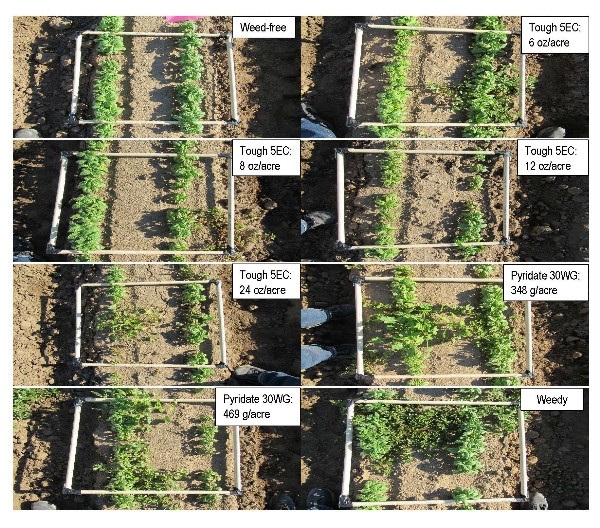From page 26 of the Progressive Crop Consultant (March/April 2022) magazine.
Zheng Wang is the UC Cooperative Extension Vegetable Crops and Irrigation Advisor for Stanislaus County.
Evaluating the potential of Pyridate-containing herbicide in basil: impacts on yield, leaf injury, and weed control
Introduction
Basil is one of the most important herb spices for the diets of people in the Central Valley. Commercial basil in California is usually grown without the use of any herbicide after seedling emergence due to the lack of registered post-emergence herbicides. Most application occurs at pre-plant or immediately after seeding using a pre-emergence herbicide. ‘Devrinol', a selective pre-emergence herbicide containing Napropamide as the active ingredient, was the only registered herbicide that has been used over the past 20 years. Consequently, growers have to deal with potential weed resistance and deploy tremendous amount of labor for hand removal if pre-emergence effects fail or decrease later in the season. In addition to the labor cost for hand harvest, the input of manual weed removal significantly increases the total production cost. Therefore, screening existing but currently unregistered post-emergence herbicides and collecting their performance on weed suppression and plant injury will facilitate the use registration and help basil growers with more choices for post-emergence chemical weed control and the labor cost reduction for manual weeding.

In 2021, I conducted two herbicide evaluation trials on commercial basil fields of Ratto Bros, Inc. in Modesto, California (37.687312, -121.192401 and 37.679212, -121.142669) with the collaboration of IR-4. The purpose is to understand if two Pyridate-containing herbicides, ‘Tough 5EC' and ‘Pyridate 30WG', perform consistently on weed control and prevention of basil leaf injury. Tough 5EC and Pyridate 30WG are currently used on field corn, chickpea, and mints but are not registered for use on basil. They both have the active ingredient of Pyridate (Carbonothioic acid, O-(6-chloro-3-phenyl-4-pyridizinyl) S-octyl ester)and are contact herbicides within Group 6. They are post-emergence herbicides for the selective control or suppression of actively growing annual broadleaf species. The active ingredient of Pyridate is absorbed by plant leaves. Neither offers any residual weed control. Therefore, weeds must have emerged at the time of spray and not grown beyond the proper application stage to prevent decrease of control.
For the complete article, see page 26 in the Progressive Crop Consultant (March/April 2022) magazine.